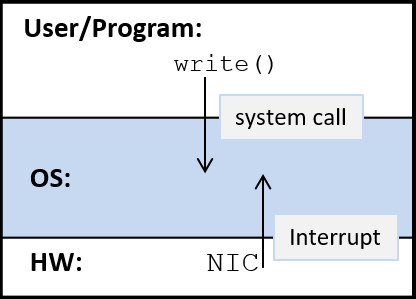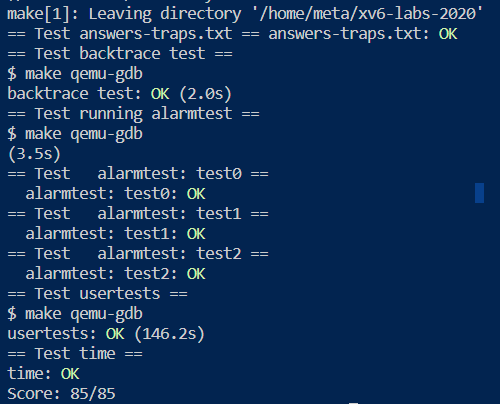本文最后更新于:2025年6月25日 上午
前置准备
RISC-V assembly (easy ) 通过make fs.img 命令可以将user/call.c文件转化为user/call.asm文件
1 2 3 4 5 6 7 8 9 10 11 12 13 14 15 16 17 18 #include "kernel/param.h" #include "kernel/types.h" #include "kernel/stat.h" #include "user/user.h" int g (int x) return x+3 ;int f (int x) return g(x);void main (void ) printf ("%d %d\n" , f(8 )+1 , 13 );exit (0 );
不难观察出:
s0寄存器(也称为fp或帧指针):它用于保存当前函数的帧指针,即指向当前函数栈帧的基址。在函数调用过程中,s0寄存器通常被用于存储上一个函数的栈帧基址,以便在函数返回时恢复调用者的栈帧。sp寄存器(也称为堆栈指针):它用于指示当前的栈顶位置,即栈指针。栈是一种后进先出(LIFO)的数据结构,用于存储局部变量、函数调用信息和其他临时数据。在函数调用期间,栈会动态增长和收缩,而sp寄存器会随着栈的变化而移动。a0保存第一个参数,同时具有存储返回值的用途(也即是x,返回x+3)。a1存储第二个参数,以此类推
f函数被内联优化,没有新开辟栈帧,它的内容和g函数相同
ra寄存器存储函数的返回地址
1 2 3 4 5 6 7 8 9 10 11 12 13 14 15 16 17 18 19 20 21 22 23 24 25 26 27 28 29 30 31 32 33 34 35 36 37 38 39 40 41 42 43 44 45 46 47 48 49 50 51 52 53 54 55
Q1 Which registers contain arguments to functions? For example, which register holds 13 in main’s call to printf?
1 2 3 4 5 6 7 8 9 10 11 12 13 14 15 reg | name | saver | description -------+-------+--------+------------ x0 | zero | | hardwired zero x1 | ra | caller | return address x2 | sp | callee | stack pointer x3 | gp | | global pointer x4 | tp | | thread pointer x5-7 | t0-2 | caller | temporary registers x8 | s0/fp | callee | saved register / frame pointer x9 | s1 | callee | saved register x10-11 | a0-1 | caller | function arguments / return values x12-17 | a2-7 | caller | function arguments x18-27 | s2-11 | callee | saved registers x28-31 | t3-6 | caller | temporary registers pc | | | program counter
a0保存第一个参数,同时具有存储返回值的用途(也即是x,返回x+3)。a1存储第二个参数,以此类推
Q2 Where is the call to function f in the assembly code for main? Where is the call to g? (Hint: the compiler may inline functions.)
代码li a1,12 直接将f(8)+1的结果存入a1中,并没有调用函数的过程,这里存在编译器的优化
Q3 At what address is the function printf located?
1 2 3 4 5 6 0000000000000616 <printf>:void printf (const char *fmt, ...) 616 : 711 d addi sp,sp,-96
616
jalr 1510(ra)指令用于调用printf函数,其中偏移量1510是相对于全局地址0x0的偏移 。(全局地址不确定)
Q4 Run the following code.
1 2 3 unsigned int i = 0 x00646 c72 ;printf ("H%x Wo%s" , 57616 , &i);
What is the output? Here’s an ASCII table that maps bytes to characters.
The output depends on that fact that the RISC-V is little-endian. If the RISC-V were instead big-endian what would you set i to in order to yield the same output? Would you need to change 57616 to a different value?
Here’s a description of little- and big-endian and a more whimsical description .
57616是0xE110
%s打印出&i指向十六进制数对应的ASCII码,遇0停止打印。变量i存储了字符串”rld\0”
最终打印出HE110 World
Q5 In the following code, what is going to be printed after 'y='? (note: the answer is not a specific value.) Why does this happen?
y=a2寄存器的值
这里printf函数相当于有三个参数,第一个是字符串(a0保存),第二个是3(a1保存),第三个((a2保存))
要求:在 kernel/printf.c 中实现一个 backtrace ()函数。在 sys _ sleep 中插入对此函数的调用,然后运行 bttest,它调用 sys _ sleep。你的输出应该如下:
1 2 3 4 backtrace: 0x000000080002cda 0x000000080002bb6 0x0000000080002898
编译器在每个堆栈帧中放入一个包含调用者帧指针地址的帧指针。您的回溯应该使用这些帧指针来遍历堆栈,并在每个堆栈帧中打印保存的返回地址。
补充一下基础知识:
栈指针:sp(stack pointer),指向栈的低地址
帧指针:fp(frame pointer),指向栈的高地址
fp-8:返回地址
fp-16:preview fp
内核会为栈分配一页的内存,因此可以使用 PGROUNDUP(fp)和 PGROUNDDOWN(fp)定位栈的上下边界,以终止循环
具体的栈的内存布局参考lecture中教授手画图
1 2 3 4 5 6 7 static inline uint64
在printf.c文件中添加函数:
1 2 3 4 5 6 7 8 9 10 11 12 void backtrace (void ) printf ("backtrace:\n" );while (fp<up_addr)-8 );printf ("%p\n" ,ret_addr);-16 );
bttest.c中如是写:
1 2 3 4 5 6 7 8 9 10 11 #include "kernel/types.h" #include "kernel/stat.h" #include "user/user.h" int main (int argc, char *argv[]) 1 );exit (0 );
因此bttest作为测试文件会调用sleep,也即是sys_sleep。我们在sys_sleep中加入如下代码:
1 2 3 4 5 6 7 8 9 10 11 12 13 14 15 16 17 18 19 20 uint64 sys_sleep (void ) int n;if (argint(0 , &n) < 0 )return -1 ;while (ticks - ticks0 < n){if (myproc()->killed){return -1 ;return 0 ;
这样的话,sleep返回之前会调用backtrace函数
类似的,为了更好的debug,在panic函数中加入如下代码:
1 2 3 4 5 6 7 8 9 10 11 12 void panic (char *s) 0 ;printf ("panic: " );printf (s);printf ("\n" );1 ; for (;;)
这样会在panic输出之后,打印出返回地址
ps :做到此处发现了的qemu卡死的问题,发现是2020版本lab的传统艺能。apt remove qemu*之后使用源码编译qemu5版本即可
Next, retrieve and extract the source for QEMU 5.1.0:
1 2 $ wget https: //download.qemu.org/qemu -5.1 .0.tar.xz$ tar xf qemu-5.1 .0.tar.xz
Build QEMU for riscv64-softmmu:
1 2 3 4 5 $ cd qemu-5.1.0./configure --disable-kvm --disable-werror --prefix=/usr/local --target-list= "riscv64-softmmu" cd ..
目标:
向 xv6添加一个特性,它将在进程使用 CPU 时间时周期性 发出警报。更一般地说,实现用户级中断/错误处理程序的基本形式; 例如,可以使用类似的东西来处理应用程序中的页面错误。
hint:
添加一个新的系统调用sigalarm(interval, handler),如果应用程序调用 sigAlarm (n,fn) ,那么在程序消耗的每 n 个 CPU 时间之后,内核应该调用应用程序函数 fn。当 fn 返回时,应用程序应该从停止的地方恢复
如果一个应用程序调用 sigAlarm (0,0) ,内核应该停止生成周期性的alarm调用
user/alarmtest.c是测试文件,需要将其添加到makefile。添加了 sigAlarm 和 sigreturn 系统调用,它才能正确编译
可以在 user/alarmtest.asm 中看到 alarmtest 的汇编代码,这可能有助于调试
alarmtest 中在 test0 调用了 sigalarm(2, periodic),要求内核强制每隔2个tick调用 period () ,然后spin一段时间
test0:修改内核以跳转到用户空间中的警报处理程序
先修改makefile编译出alarmtest
1 2 3 4 5 6 7 8 9 10 11 12 13 14 15 16 17 18 UPROGS=\
放入 user/user.h 中的正确声明:
1 2 3 4 5 6 7 8 9 10 11 12 13 14 15 16 17 18 19 20 21 22 23 24 25 26 27 28 29 30 31 32 33 34 35 36 37 38 39 40 41 int sigalarm (int ticks, void (*handler)()) int sigreturn (void ) int fork (void ) int exit (int ) __attribute__ ((noreturn)) int wait (int *) int pipe (int *) int write (int , const void *, int ) int read (int , void *, int ) int close (int ) int kill (int ) int exec (char *, char **) int open (const char *, int ) int mknod (const char *, short , short ) int unlink (const char *) int fstat (int fd, struct stat*) int link (const char *, const char *) int mkdir (const char *) int chdir (const char *) int dup (int ) int getpid (void ) char * sbrk (int ) int sleep (int ) int uptime (void ) int stat (const char *, struct stat*) char * strcpy (char *, const char *) void *memmove (void *, const void *, int ) char * strchr (const char *, char c) int strcmp (const char *, const char *) void fprintf (int , const char *, ...) void printf (const char *, ...) char * gets (char *, int max) uint strlen (const char *) ;void * memset (void *, int , uint) void * malloc (uint) void free (void *) int atoi (const char *) int memcmp (const void *, const void *, uint) void *memcpy (void *, const void *, uint)
更新 user/usys.pl (生成 user/usys.S)
1 2 3 4 5 6 7 8 9 10 11 12 13 14 15 16 17 18 19 20 21 22 23 24 25 26 27 28 29 30 31 32 33 34 35 36 37 38 39 40 #!/usr/bin/perl -wfor syscalls."# generated by usys.pl - do not edit\n" ;"#include \"kernel/syscall.h\"\n" ;".global $name\n" ;"${name}:\n" ;" li a7, SYS_${name}\n" ;" ecall\n" ;" ret\n" ;"fork" );"exit" );"wait" );"pipe" );"read" );"write" );"close" );"kill" );"exec" );"open" );"mknod" );"unlink" );"fstat" );"link" );"mkdir" );"chdir" );"dup" );"getpid" );"sbrk" );"sleep" );"uptime" );"sigalarm" );"sigreturn" );
kernel/syscall.h
1 2 3 4 5 6 7 8 9 10 11 12 13 14 15 16 17 18 19 20 21 22 23 24 #define SYS_fork 1 #define SYS_exit 2 #define SYS_wait 3 #define SYS_pipe 4 #define SYS_read 5 #define SYS_kill 6 #define SYS_exec 7 #define SYS_fstat 8 #define SYS_chdir 9 #define SYS_dup 10 #define SYS_getpid 11 #define SYS_sbrk 12 #define SYS_sleep 13 #define SYS_uptime 14 #define SYS_open 15 #define SYS_write 16 #define SYS_mknod 17 #define SYS_unlink 18 #define SYS_link 19 #define SYS_mkdir 20 #define SYS_close 21 #define SYS_sigalarm 22 #define SYS_sigreturn 23
kernel/syscall.c
1 2 3 4 5 6 7 8 9 10 11 12 13 14 15 16 17 18 19 20 21 22 23 24 25 26 27 28 29 30 31 32 33 34 35 36 37 38 39 40 41 42 43 44 45 46 47 48 49 50 extern uint64 sys_chdir (void ) extern uint64 sys_close (void ) extern uint64 sys_dup (void ) extern uint64 sys_exec (void ) extern uint64 sys_exit (void ) extern uint64 sys_fork (void ) extern uint64 sys_fstat (void ) extern uint64 sys_getpid (void ) extern uint64 sys_kill (void ) extern uint64 sys_link (void ) extern uint64 sys_mkdir (void ) extern uint64 sys_mknod (void ) extern uint64 sys_open (void ) extern uint64 sys_pipe (void ) extern uint64 sys_read (void ) extern uint64 sys_sbrk (void ) extern uint64 sys_sleep (void ) extern uint64 sys_unlink (void ) extern uint64 sys_wait (void ) extern uint64 sys_write (void ) extern uint64 sys_uptime (void ) extern uint64 sys_sigalarm (void ) extern uint64 sys_sigreturn (void ) static uint64 (*syscalls[]) (void )
在sysproc.c中加入sys_sigalarm和sys_sigreturn函数处理代码
1 2 3 4 5 6 7 8 9 10 11 12 13 14 15 16 17 18 19 20 uint64 sys_sigalarm (void ) int n;if (argint(0 , &n) < 0 ) {return -1 ;if (argaddr(1 , &fn) < 0 ) {return -1 ;return sigalarm(n, (void (*)())(fn));uint64 sys_sigreturn (void ) return sigreturn();
关于test1的提示:
解决方案将要求您保存和恢复寄存器– 您需要保存和恢复哪些寄存器才能正确地恢复被中断的代码?(提示: 会有很多)。
当计时器关闭时,用户陷阱在 struct proc 中保存足够的状态,这样签名返回就可以正确地返回到被中断的用户代码。
防止对处理程序的重入调用——如果处理程序还没有返回,内核就不应该再次调用它。
硬件时钟每次都强制执行一个中断,这个中断在 kernel/trap.c 中的 usertrap ()中处理。每次时钟发生硬件中断,都统计一次,到了次数就执行handler
在proc中加入如下变量:
1 2 3 4 5 6 7 8 9 10 11 12 13 14 15 16 17 18 19 20 21 22 23 24 25 26 27 28 struct proc {struct spinlock lock ;enum procstate state ;struct proc *parent ;void *chan; int killed; int xstate; int pid; pagetable_t pagetable; struct trapframe *trapframe ;struct context context ;struct file *ofile [NOFILE ];struct inode *cwd ;char name[16 ]; int alarm_interval; void (*alarm_handler)();int alarm_ticks;struct trapframe *saved_trapframe ;int alarm_flag;
完善sigalarm和sigreturn函数,并在defs.h中加入声明
1 2 3 4 5 6 7 8 9 10 11 12 13 14 15 16 17 18 19 20 21 22 int sigalarm (int , void (*)()) int sigreturn (void ) int sigalarm (int ticks, void (*handler)()) struct proc *p =return 0 ;int sigreturn (void ) struct proc *p =0 ;return 0 ;
allocproc函数和freeproc函数也需要更新
对进程的字段进行初始化和销毁以及页的申请
使用kalloc给p->saved_trapframe分配空间
使用kfree((void *)p->saved_trapframe);销毁空间
1 2 3 4 5 6 7 8 9 10 11 12 13 14 15 16 17 18 19 20 21 22 23 24 25 26 27 28 29 30 31 32 33 34 35 36 37 38 39 40 41 42 43 44 45 46 47 48 49 50 51 52 53 54 55 56 57 58 59 60 61 62 63 64 65 66 67 68 69 70 71 72 73 74 75 76 77 78 79 80 81 82 83 84 85 86 static struct proc*allocproc (void ) struct proc *p ;for (p = proc; p < &proc[NPROC]; p++) {if (p->state == UNUSED) {goto found;else {return 0 ;if ((p->trapframe = (struct trapframe *)kalloc()) == 0 ){return 0 ;if (p->pagetable == 0 ){return 0 ;if ((p->saved_trapframe = (struct trapframe *)kalloc()) == 0 ){return 0 ;memset (&p->context, 0 , sizeof (p->context));0 ;0 ;0 ;0 ;return p;static void freeproc (struct proc *p) if (p->trapframe)void *)p->trapframe);0 ;if (p->pagetable)if (p->saved_trapframe)void *)p->saved_trapframe);0 ;0 ;0 ;0 ;0 ] = 0 ;0 ;0 ;0 ;0 ;0 ;0 ;0 ;
评分

